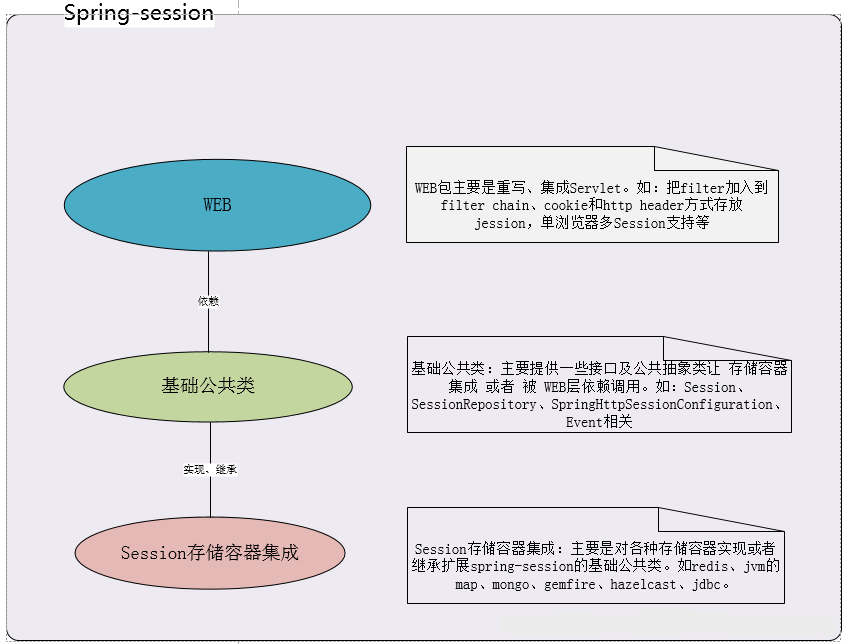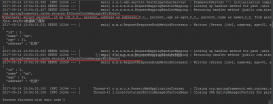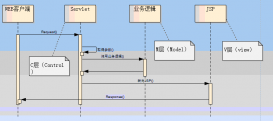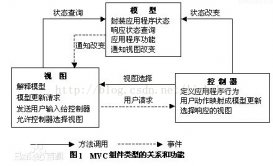1.简介
session一直都是我们做集群时需要解决的一个难题,过去我们可以从serlvet容器上解决,比如开源servlet容器-tomcat提供的tomcat-redis-session-manager、memcached-session-manager。
或者通过nginx之类的负载均衡做ip_hash,路由到特定的服务器上..
但是这两种办法都存在弊端。
|
1
|
spring-session是spring旗下的一个项目,把servlet容器实现的httpSession替换为spring-session,专注于解决 session管理问题。可简单快速且无缝的集成到我们的应用中。 |
2.支持功能
1)轻易把session存储到第三方存储容器,框架提供了redis、jvm的map、mongo、gemfire、hazelcast、jdbc等多种存储session的容器的方式。
2)同一个浏览器同一个网站,支持多个session问题。
3)RestfulAPI,不依赖于cookie。可通过header来传递jessionID
4)WebSocket和spring-session结合,同步生命周期管理。
3.集成方式
集成方式非常简单,直接看官网的samplesandguide。http://docs.spring.io/spring-session/docs/1.3.0.RELEASE/reference/html5/
主要分为以下几个集成步骤:
1)引入依赖jar包
2)注解方式或者xml方式配置特定存储容器的存储方式,如redis的xml配置方式
|
1
2
3
4
5
|
<context:annotation-config/> /** 初始化一切spring-session准备,且把springSessionFilter放入IOC **/<beanclass="org.springframework.session.data.redis.config.annotation.web.http.RedisHttpSessionConfiguration"/> /** 这是存储容器的链接池 **/ <beanclass="org.springframework.data.redis.connection.lettuce.LettuceConnectionFactory"/> |
3)xml方式配置 web.xml ,配置 springSessionFilter到 filter chain中
|
1
2
3
4
5
6
7
8
9
|
<filter> <filter-name>springSessionRepositoryFilter</filter-name> <filter-class>org.springframework.web.filter.DelegatingFilterProxy</filter-class> </filter> <filter-mapping> <filter-name>springSessionRepositoryFilter</filter-name> <url-pattern>/*</url-pattern> <dispatcher>REQUEST</dispatcher><dispatcher>ERROR</dispatcher> </filter-mapping> |
二:spring-session框架内部剖析
1.框架高层抽象结构图

2.spring-session重写servlet request 及 redis实现存储相关问题
spring-session无缝替换应用服务器的request大概原理是:
1.自定义个Filter,实现doFilter方法
2.继承 HttpServletRequestWrapper 、HttpServletResponseWrapper 类,重写getSession等相关方法(在这些方法里调用相关的 session存储容器操作类)。
3.在 第一步的doFilter中,new 第二步 自定义的request和response的类。并把它们分别传递 到 过滤器链
4.把该filter配置到 过滤器链的第一个位置上
|
1
2
3
4
5
6
7
8
9
10
11
12
13
14
15
16
17
18
19
20
21
22
23
24
25
26
27
28
29
30
31
32
33
34
35
36
37
38
39
40
41
42
43
44
45
46
47
48
49
50
51
52
53
54
55
56
57
58
59
60
61
62
63
64
65
66
67
68
69
70
71
72
73
74
75
76
77
78
79
80
81
82
83
84
85
86
87
88
89
90
91
92
93
94
95
96
97
98
99
100
101
102
103
104
105
106
107
108
109
110
111
112
113
114
115
116
117
118
119
120
121
122
123
124
125
126
127
128
129
130
131
132
133
134
135
136
137
138
139
140
141
142
143
144
145
146
147
148
149
150
151
152
153
154
155
156
157
158
159
160
161
162
163
164
165
166
167
168
169
170
171
172
173
174
175
176
177
178
179
180
181
182
183
184
185
186
187
188
189
190
191
192
193
194
195
196
197
198
199
200
201
202
203
204
205
206
207
208
209
210
211
212
213
214
215
216
217
218
219
220
221
222
223
224
225
226
227
228
229
230
231
232
233
234
235
236
237
238
239
240
241
242
243
244
245
246
247
248
249
250
251
252
253
254
255
256
257
258
259
260
261
262
263
264
265
266
267
268
269
270
271
272
273
274
275
276
277
278
279
280
281
282
283
284
285
286
287
288
289
290
291
292
293
294
295
296
297
298
299
300
301
302
303
304
305
306
307
308
309
310
311
312
313
314
315
316
317
318
319
320
321
322
323
324
325
326
327
328
|
/** 这个类是spring-session的1.30源码,也是实现上面第一到第三步的关键类 **/public class SessionRepositoryFilter<S extends ExpiringSession> extends OncePerRequestFilter { /** session存储容器接口,redis、mongoDB、genfire等数据库都是实现该接口 **/ private final SessionRepository<S> sessionRepository; private ServletContext servletContext; /** sessionID的传递方式接口。目前spring-session自带两个实现类 1.cookie方式 :CookieHttpSessionStrategy 2.http header 方式:HeaderHttpSessionStrategy 当然,我们也可以自定义其他方式。 **/ private MultiHttpSessionStrategy httpSessionStrategy = new CookieHttpSessionStrategy(); public SessionRepositoryFilter(SessionRepository<S> sessionRepository) { if (sessionRepository == null) { throw new IllegalArgumentException("sessionRepository cannot be null"); } this.sessionRepository = sessionRepository; } public void setHttpSessionStrategy(HttpSessionStrategy httpSessionStrategy) { if (httpSessionStrategy == null) { throw new IllegalArgumentException("httpSessionStrategy cannot be null"); } /** 通过前面的spring-session功能介绍,我们知道spring-session可以支持单浏览器多 session, 就是通过MultiHttpSessionStrategyAdapter来实现的。 每个浏览器拥有一个sessionID,但是这个sessionID拥有多个别名(根据浏览器的tab)。如: 别名1 sessionID 别名2 sessionID ... 而这个别名通过url来传递,这就是单浏览器多session原理了 **/ this.httpSessionStrategy = new MultiHttpSessionStrategyAdapter( httpSessionStrategy); } public void setHttpSessionStrategy(MultiHttpSessionStrategy httpSessionStrategy) { if (httpSessionStrategy == null) { throw new IllegalArgumentException("httpSessionStrategy cannot be null"); } this.httpSessionStrategy = httpSessionStrategy; } /** 该方法相当于重写了doFilter,只是spring-session又做了多一层封装。 在这个方法里创建自定义的 request和response,然后传递到过滤器链filterChain **/ @Override protected void doFilterInternal(HttpServletRequest request, HttpServletResponse response, FilterChain filterChain) throws ServletException, IOException { request.setAttribute(SESSION_REPOSITORY_ATTR, this.sessionRepository); /** spring-session重写的ServletRequest。这个类继承了HttpServletRequestWrapper **/ SessionRepositoryRequestWrapper wrappedRequest = new SessionRepositoryRequestWrapper( request, response, this.servletContext); SessionRepositoryResponseWrapper wrappedResponse = new SessionRepositoryResponseWrapper( wrappedRequest, response); HttpServletRequest strategyRequest = this.httpSessionStrategy .wrapRequest(wrappedRequest, wrappedResponse); HttpServletResponse strategyResponse = this.httpSessionStrategy .wrapResponse(wrappedRequest, wrappedResponse); try { /** 传递自定义 request和response到链中,想象下如果 该spring-sessionFilter位于过滤器链的第一个,那么后续的Filter, 以及到达最后的控制层所获取的 request和response,是不是就是我们自定义的了? **/ filterChain.doFilter(strategyRequest, strategyResponse); } finally { wrappedRequest.commitSession(); } } public void setServletContext(ServletContext servletContext) { this.servletContext = servletContext; } /** 这个就是Servlet response的重写类了 */ private final class SessionRepositoryResponseWrapper extends OnCommittedResponseWrapper { private final SessionRepositoryRequestWrapper request; SessionRepositoryResponseWrapper(SessionRepositoryRequestWrapper request, HttpServletResponse response) { super(response); if (request == null) { throw new IllegalArgumentException("request cannot be null"); } this.request = request; } /** 这步是持久化session到存储容器,我们可能会在一个控制层里多次调用session的操作方法 如果我们每次对session的操作都持久化到存储容器,必定会带来性能的影响。比如redis 所以我们可以在整个控制层执行完毕了,response返回信息到浏览器时,才持久化session **/ @Override protected void onResponseCommitted() { this.request.commitSession(); } } /** spring-session 的request重写类,这几乎是最重要的一个重写类。里面重写了获取getSession,Session等方法以及类 */ private final class SessionRepositoryRequestWrapper extends HttpServletRequestWrapper { private Boolean requestedSessionIdValid; private boolean requestedSessionInvalidated; private final HttpServletResponse response; private final ServletContext servletContext; private SessionRepositoryRequestWrapper(HttpServletRequest request, HttpServletResponse response, ServletContext servletContext) { super(request); this.response = response; this.servletContext = servletContext; } /** * Uses the HttpSessionStrategy to write the session id to the response and * persist the Session. */ private void commitSession() { HttpSessionWrapper wrappedSession = getCurrentSession(); if (wrappedSession == null) { // session失效,删除cookie或者header if (isInvalidateClientSession()) { SessionRepositoryFilter.this.httpSessionStrategy .onInvalidateSession(this, this.response); } } else { S session = wrappedSession.getSession(); SessionRepositoryFilter.this.sessionRepository.save(session); if (!isRequestedSessionIdValid() || !session.getId().equals(getRequestedSessionId())) { // 把cookie或者header写回给浏览器保存 SessionRepositoryFilter.this.httpSessionStrategy.onNewSession(session, this, this.response); } } } @SuppressWarnings("unchecked") private HttpSessionWrapper getCurrentSession() { return (HttpSessionWrapper) getAttribute(CURRENT_SESSION_ATTR); } private void setCurrentSession(HttpSessionWrapper currentSession) { if (currentSession == null) { removeAttribute(CURRENT_SESSION_ATTR); } else { setAttribute(CURRENT_SESSION_ATTR, currentSession); } } @SuppressWarnings("unused") public String changeSessionId() { HttpSession session = getSession(false); if (session == null) { throw new IllegalStateException( "Cannot change session ID. There is no session associated with this request."); } // eagerly get session attributes in case implementation lazily loads them Map<String, Object> attrs = new HashMap<String, Object>(); Enumeration<String> iAttrNames = session.getAttributeNames(); while (iAttrNames.hasMoreElements()) { String attrName = iAttrNames.nextElement(); Object value = session.getAttribute(attrName); attrs.put(attrName, value); } SessionRepositoryFilter.this.sessionRepository.delete(session.getId()); HttpSessionWrapper original = getCurrentSession(); setCurrentSession(null); HttpSessionWrapper newSession = getSession(); original.setSession(newSession.getSession()); newSession.setMaxInactiveInterval(session.getMaxInactiveInterval()); for (Map.Entry<String, Object> attr : attrs.entrySet()) { String attrName = attr.getKey(); Object attrValue = attr.getValue(); newSession.setAttribute(attrName, attrValue); } return newSession.getId(); } // 判断session是否有效 @Override public boolean isRequestedSessionIdValid() { if (this.requestedSessionIdValid == null) { String sessionId = getRequestedSessionId(); S session = sessionId == null ? null : getSession(sessionId); return isRequestedSessionIdValid(session); } return this.requestedSessionIdValid; } private boolean isRequestedSessionIdValid(S session) { if (this.requestedSessionIdValid == null) { this.requestedSessionIdValid = session != null; } return this.requestedSessionIdValid; } private boolean isInvalidateClientSession() { return getCurrentSession() == null && this.requestedSessionInvalidated; } private S getSession(String sessionId) { // 从session存储容器中根据sessionID获取session S session = SessionRepositoryFilter.this.sessionRepository .getSession(sessionId); if (session == null) { return null; } // 设置sesison的最后访问时间,以防过期 session.setLastAccessedTime(System.currentTimeMillis()); return session; } /** 这个方法是不是很熟悉,下面还有个getSession()才更加熟悉。没错,就是在这里重新获取session方法 **/ @Override public HttpSessionWrapper getSession(boolean create) { //快速获取session,可以理解为一级缓存、二级缓存这种关系 HttpSessionWrapper currentSession = getCurrentSession(); if (currentSession != null) { return currentSession; } //从httpSessionStratge里面根据cookie或者header获取sessionID String requestedSessionId = getRequestedSessionId(); if (requestedSessionId != null && getAttribute(INVALID_SESSION_ID_ATTR) == null) { //从存储容器获取session以及设置当次初始化属性 S session = getSession(requestedSessionId); if (session != null) { this.requestedSessionIdValid = true; currentSession = new HttpSessionWrapper(session, getServletContext()); currentSession.setNew(false); setCurrentSession(currentSession); return currentSession; } else { if (SESSION_LOGGER.isDebugEnabled()) { SESSION_LOGGER.debug( "No session found by id: Caching result for getSession(false) for this HttpServletRequest."); } setAttribute(INVALID_SESSION_ID_ATTR, "true"); } } if (!create) { return null; } if (SESSION_LOGGER.isDebugEnabled()) { SESSION_LOGGER.debug( "A new session was created. To help you troubleshoot where the session was created we provided a StackTrace (this is not an error). You can prevent this from appearing by disabling DEBUG logging for " + SESSION_LOGGER_NAME, new RuntimeException( "For debugging purposes only (not an error)")); } // 如果该浏览器或者其他http访问者是初次访问服务器,则为他创建个新的session S session = SessionRepositoryFilter.this.sessionRepository.createSession(); session.setLastAccessedTime(System.currentTimeMillis()); currentSession = new HttpSessionWrapper(session, getServletContext()); setCurrentSession(currentSession); return currentSession; } @Override public ServletContext getServletContext() { if (this.servletContext != null) { return this.servletContext; } // Servlet 3.0+ return super.getServletContext(); } @Override public HttpSessionWrapper getSession() { return getSession(true); } @Override public String getRequestedSessionId() { return SessionRepositoryFilter.this.httpSessionStrategy .getRequestedSessionId(this); } /** HttpSession的重写类 */ private final class HttpSessionWrapper extends ExpiringSessionHttpSession<S> { HttpSessionWrapper(S session, ServletContext servletContext) { super(session, servletContext); } @Override public void invalidate() { super.invalidate(); SessionRepositoryRequestWrapper.this.requestedSessionInvalidated = true; setCurrentSession(null); SessionRepositoryFilter.this.sessionRepository.delete(getId()); } } }} |
总结
以上就是本文关于spring-session简介及实现原理源码分析的全部内容,希望对大家有所帮助。感兴趣的朋友可以继续参阅本站其他相关专题,如有不足之处,欢迎留言指出!
原文链接:http://blog.csdn.net/wojiaolinaaa/article/details/62424642
















